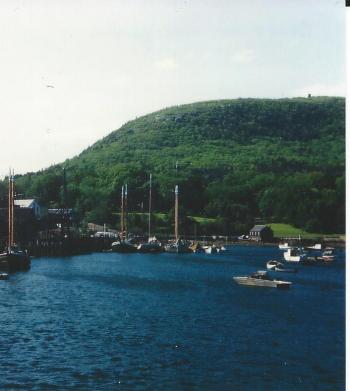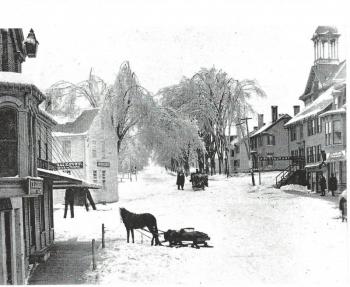Barbara Dyer: Camden in 1880
None of us were here in the year 1880, but Camden was. Some things have not changed but many things are quite different today.
Camden did include what is now Rockport ( then called Goose River), West Rockport (then called West Camden), Rockville and Glen Cove (then called Clam Cove). So it did include 26,800 acres. It was situated on the western side of Penobscot Bay and was the north-eastern town of Knox County.
The Native American name of it was Megunticook, signifying great sea-swells. Grouped within the town were five mountains: Mt. Megunticook was about 1,600 feet in height; then it was said Mt. Battie, Bald Mountain, Ragged Mountain and Mt. Pleasant, none of their summits fell below 900 feet above the sea. They, more or less, were dressed in forest trees to the top.
They were visible about 20 leagues distant, and were supposed to have been the boundaries between the great Bashaba's dominions situated on the west and those of the Tarratine tribes on the east and north.
Camden had six ponds: Lily, Hosmer, Canaan, Grassy, Rocky, five considerable streams and twenty-one water powers. Fourteen of the dams are probably 2 ½ miles from Camden harbor, as the crow flies, and Megunticook River actually is 3 ½ miles long. In this distance it has a fall of 150 feet.
The manufacturers in Camden village consisted of foundry products, railroad cars, woolen and paper mills, felting, anchors, wedges, plugs, treenails, planking, powder kegs, mattresses, gun powder, dynamite, barrel head machines, tin-ware, oakum, wool-rolls, carriages, boots, shoes, leather, flour meal, ships and boats. West Camden made corn-brooms, carriages, cooperage, meal, lime, etc. Rockville the products were carriages, boots and shoes. There were sixteen lime kilns, three shipyards, four grist mills, and six saw mills. Lime rock was the principal rock under the soil. Hay was the principal crop export and Camden was on the stage line from Bangor to Rockland. It was also on the steamboat line from Boston to Bangor.
Each village had nice buildings and streets shaded by various trees. There were post offices in Camden village, Goose River, West Camden and Rockville. Camden Savings Bank had deposits and profits amounting to $145,672.72. The Camden National Bank had a capital of $50,000.00. The Camden Herald carried local, national and foreign news and issued every Saturday by W. W. Perry.
The churches in the town were three: Methodist, two Episcopal, four Baptist, two Universalist and a Congregational. It also had an excellent new town hall, three libraries and two book clubs. The town has 16 public schoolhouses valued at $11,650. Its population was 4,386.
It is fair to say, “Times have changed.” Camden separated from the other small places mentioned 100 years after it was incorporated. There is much less manufacturing and more tourism. All the towns have their natural beauty.
Barbara F. Dyer has lived in Camden all of her life, so far.
More Barbara Dyer
When President Roosevelt took the train from Rockland to Washington, D.C.
Carlos Salzedos' harp colony in Camden
Buttoning up the harbor for winter
The day when Camden burned down, 40 buildings lay in ash
Old Glory, the flag’s storied history, and proper etiquette
The Seaside Mountains of Camden
The story of the Barbie D, a little tug that has worked Camden Harbor for 60-plus years
Postcards and the way we communicated 100 years ago
The Babbs: A family integral to Camden history
When Camden paid a fine for having no minister preaching in town
The demise of a Camden-built vessel
Camden’s wooden boat builders were perfectionists
Building wooden boats in Camden, many years ago
Socializing and such, before television
The first years of the Camden Snow Bowl
The many moods of Camden Harbor
Demise of the Camden steamboat wharf
Curtis Island Lighthouse - the sentinel of Camden Harbor
Camden Harbor: As old as the last glacier




































